Electrochemical Processing and Thermal Properties of Functional Core/Multi-Shell ZnAl/Ni/NiP Microparticles
Abstract
1. Introduction
2. Materials and Methods
2.1. Powder Feedstock and Material Characterization
2.2. Two-Step Core-Shell Encapsulation Process
2.2.1. Step #1—Ni Cementation
2.2.2. Step #2—NiP Autocatalytic Deposition
3. Results and Discussion
3.1. Introduction of the Challenge: One-Step NiP Autocatalytic Deposition on ZnAl Powder
3.2. First-Step Cementation in Ethanol
3.2.1. The Effect of Temperature
3.2.2. The Effect of NiCl2 Concentration
3.2.3. The Effect of Process Time
3.3. Second-Step Encapsulation of ZnAl/Ni Particles
3.4. Characterization of the ZnAl/Ni/NiP Core-Shell Powder
4. Conclusions
Author Contributions
Funding
Institutional Review Board Statement
Informed Consent Statement
Data Availability Statement
Acknowledgments
Conflicts of Interest
References
- Galogahi, F.M.; Zhu, Y.; An, H.; Nguyen, N.-T. Core-shell microparticles: Generation approaches and applications. J. Sci. Adv. Mater. Devices 2020, 5, 417–435. [Google Scholar] [CrossRef]
- Wei, S.; Wang, Q.; Zhu, J.; Sun, L.; Lin, H.; Guo, Z. Multifunctional composite core–shell nanoparticles. Nanoscale 2011, 3, 4474–4502. [Google Scholar] [CrossRef]
- Kawaguchi, T.; Sakai, H.; Sheng, N.; Kurniawan, A.; Nomura, T. Microencapsulation of Zn-Al alloy as a new phase change material for middle-high-temperature thermal energy storage applications. Appl. Energy 2020, 276, 115487. [Google Scholar] [CrossRef]
- Yu, F.; Chen, H.; Hang, C.; Li, M. Fabrication of high-temperature-resistant bondline based on multilayer core–shell hybrid microspheres for power devices. J. Mater. Sci. Mater. Electron. 2019, 30, 3595–3603. [Google Scholar] [CrossRef]
- Zhang, Y.S.; Zhao, Y.H.; Zhang, W.; Lu, J.W.; Hu, J.J.; Huo, W.T.; Zhang, P.X. Core-shell structured titanium-nitrogen alloys with high strength, high thermal stability and good plasticity. Sci. Rep. 2017, 7, 40039. [Google Scholar] [CrossRef] [PubMed]
- Chen, C.W.; Tsai, H.W.; Wang, Y.C.; Su, T.Y.; Yang, C.H.; Lin, W.S.; Lin, Z.H.; Huang, J.S.; Chueh, Y.L. Design of novel TiO2–SiO2 core-shell helical nanostructured anti-reflective coatings on Cu (In,Ga)Se2 solar cells with enhanced power conversion efficiency. J. Mater. Chem. A 2019, 7, 11452–11459. [Google Scholar] [CrossRef]
- Shukla, R.S.; Zala, V.B.; Gupta, S.K.; Gajjar, P.N. Metallic Sb/GaAs core/shell nanowire as cold anti-reflective coating for optical fibres. Mater. Today Proceed. 2020, 28, 230–233. [Google Scholar] [CrossRef]
- Zheng, B.; Topping, T.; Smugeresky, J.E.; Zhou, Y.; Biswas, A.; Baker, D.; Lavernia, E.J. The influence of Ni-coated TiC on laser-deposited IN625 metal matrix composites. Metall. Mater. Trans. A 2010, 41, 568–573. [Google Scholar] [CrossRef]
- Walker, D.C.; Caley, W.F.; Brochu, M. Selective laser sintering of composite copper–tin powders. J. Mater. Res. 2014, 29, 1997–2005. [Google Scholar] [CrossRef]
- Zheng, B.; Li, Y.; Smugeresky, J.E.; Zhou, Y.; Baker, D.; Lavernia, E.J. Hybrid Al + Al3Ni metallic foams synthesized in situ via laser engineered net shaping. Philos. Mag. 2011, 91, 3473–3497. [Google Scholar] [CrossRef]
- Jiang, C.; Lu, J.; Liu, W.; Xing, Y.; Zhang, F.; Chen, Y. Corrosion resistance of plasma-sprayed Fe-based coatings by using core-shell structure powders. J. Mater. Res. Technol. 2020, 9, 12273–12280. [Google Scholar] [CrossRef]
- Yu, F.; Wang, B.; Guo, Q.; Ma, X.; Li, M.; Chen, H. Ag@ Sn core-shell powder preform with a high re-melting temperature for high-temperature power devices packaging. Adv. Eng. Mater. 2018, 20, 1700524. [Google Scholar] [CrossRef]
- Kim, M.G.; Sim, S.; Cho, J. Novel core-shell Sn-Cu anodes for lithium rechargeable batteries prepared by a redox transmetalation reaction. Adv. Mater. 2010, 22, 5154–5158. [Google Scholar] [CrossRef] [PubMed]
- Li, Y.; Dai, H. Recent advances in zinc–air batteries. Chem. Soc. Rev. 2014, 43, 5257–5275. [Google Scholar] [CrossRef]
- Wieters, K.-P.; Kieback, B. Coated metal powder, sintering behavior and application in alternative forming processes. In Proceedings of the 15th International Plansee Seminar, Reutte, Austria, 12 May 2001. [Google Scholar]
- Flemmig, K.; Wieters, K.P.; Kieback, B. The sintering behaviour of coated particles. In Proceedings of the Sintering ’05–The 4th International Conference on Science, Technology and Applications of Sintering, Grenoble, France, 29 August–1 September 2005; pp. 21–24. [Google Scholar]
- Tan, C.; Li, S.F.; Yang, Y.F.; Zhu, Q.S.; Hu, C.Q.; Shi, Y.; Lv, P.P. Sintering response and equiaxed α-Ti grain formation in the Ti alloys sintered from Ti@Ni core–shell powders. Metall. Mater. Trans. A 2018, 49, 3394–3401. [Google Scholar] [CrossRef]
- Maeda, K.; Childs, T.H.C. Laser sintering (SLS) of hard metal powders for abrasion resistant coatings. J. Mater. Process. Technol. 2004, 149, 609–615. [Google Scholar] [CrossRef]
- Rahmani, F.; Jeon, J.; Jiang, S.; Nouranian, S. Melting and solidification behavior of Cu/Al and Ti/Al bimetallic core/shell nanoparticles during additive manufacturing by molecular dynamics simulation. J. Nanopart. Res. 2018, 20, 133. [Google Scholar] [CrossRef]
- Singh, A.; Ramakrishnan, A.; Baker, D.; Biswas, A.; Dinda, G. Laser metal deposition of nickel coated Al 7050 alloy. J. Alloy Compd. 2017, 719, 151–158. [Google Scholar] [CrossRef]
- Zhao, W.; Zheng, Y.; Sabol, J.C.; Öztekin, A.; Neti, S.; Tuzla, K.; Misiolek, W.M.; Chen, J.C. Thermal energy storage using zinc as encapsulated phase change material. ASME Int. Mech. Eng. Congr. Expo. 2011, 849–856. [Google Scholar] [CrossRef]
- Zhang, G.; Li, J.; Chen, Y.; Xiang, H.; Ma, B.; Xu, Z.; Ma, X. Encapsulation of copper-based phase change materials for high temperature thermal energy storage. Sol. Energy Mater. Sol. Cells 2014, 128, 131–137. [Google Scholar] [CrossRef]
- Chen, H.; Hu, T.; Li, M.; Zhao, Z. Cu@Sn core–shell structure powder preform for high-temperature applications based on transient liquid phase bonding. IEEE Trans. Power Electron. 2016, 32, 441–451. [Google Scholar] [CrossRef]
- Guo, Q.; Mingyu, L.; Chen, H.; Li, M. Microstructure evolution during reflow and thermal aging in a Ag@Sn TLP bondline for high-temperature power devices. J. Mater. Sci. Mater. Electron. 2018, 29, 3014–3024. [Google Scholar] [CrossRef]
- Yu, F.; Liu, H.; Hang, C.; Chen, H.; Li, M. Rapid formation of full intermetallic bondlines for die attachment in high-temperature power devices based on micro-sized Sn-coated Ag particles. JOM 2019, 71, 3049–3056. [Google Scholar] [CrossRef]
- Adhyapak, P.; Aiyer, R.; Dugasani, S.R.; Kim, H.U.; Song, C.K.; Vinu, A.; Renugopalakrishnan, V.; Park, S.H.; Kim, T.; Lee, H.; et al. Thickness-dependent humidity sensing by poly (vinyl alcohol) stabilized Au–Ag and Ag–Au core–shell bimetallic nanomorph resistors. R. Soc. Open Sci. 2018, 5, 171986. [Google Scholar] [CrossRef]
- Yang, Y.; Song, L.; Huang, T.; Chen, K.; Cheng, Q.; Lin, H.; Xiao, P.; Liang, Y.; Qiang, M.; Su, F.; et al. Asymmetrical molecular decoration of gold nanorods for engineering of shape-controlled AuNR@Ag core–shell nanostructures. Langmuir 2019, 35, 16900–16906. [Google Scholar] [CrossRef] [PubMed]
- Srisombat, L.; Nonkumwong, J.; Suwannarat, K.; Kuntalue, B.; Ananta, S. Simple preparation Au/Pd core/shell nanoparticles for 4-nitrophenol reduction. Colloid. Surf. A Physicochem. Eng. Asp. 2017, 512, 17–25. [Google Scholar] [CrossRef]
- Pola, A.; Tocci, M.; Goodwin, F. Review of microstructures and properties of zinc alloys. Metals 2020, 10, 253. [Google Scholar] [CrossRef]
- Risueño, E.; Faik, A.; Gil, A.; Rodríguez-Aseguinolaza, J.; Tello, M.; D’Aguanno, B. Zinc-rich eutectic alloys for high energy density latent heat storage applications. J. Alloys Compd. 2017, 705, 714–721. [Google Scholar] [CrossRef]
- Adinberg, R.Z.; Zvegilsky, D.; Epstein, M. Heat transfer efficient thermal energy storage for steam generation. Energy Convers. Manag. 2010, 51, 9–15. [Google Scholar] [CrossRef]
- Khare, S.; Dell’Amico, M.; Knight, C.; McGarry, S. Selection of materials for high temperature latent heat energy storage. Sol. Energy Mater. Sol. Cells 2012, 107, 20–27. [Google Scholar] [CrossRef]
- Hoshi, A.; Mills, D.R.; Bittar, A.; Saitoh, T.S. Screening of high melting point phase change materials (PCM) in solar thermal concentrating technology based on CLFR. Sol. Energy 2005, 79, 332–339. [Google Scholar] [CrossRef]
- Höhlein, S.; König-Haagen, A.; Brüggemann, D. Macro-encapsulation of inorganic phase-change materials (PCM) in metal capsules. Materials 2018, 11, 1752. [Google Scholar] [CrossRef]
- Blaney, J.J.; Neti, S.; Misiolek, W.Z.; Öztekin, A. Containment capsule stresses for encapsulated phase change materials. Appl. Therm. Eng. 2013, 50, 555–561. [Google Scholar] [CrossRef]
- Nomura, T.; Zhu, C.; Sheng, N.; Saito, G.; Akiyama, T. Microencapsulation of metal-based phase change material for high-temperature thermal energy storage. Sci. Rep. 2015, 5, 9117. [Google Scholar] [CrossRef] [PubMed]
- Cho, Y.-D.; Fey, G.T.-K. Surface treatment of zinc anodes to improve discharge capacity and suppress hydrogen gas evolution. J. Power Sources 2008, 184, 610–616. [Google Scholar] [CrossRef]
- Kundu, S.; Das, S.K.; Sahoo, P. Properties of electroless nickel at elevated temperature—A Review. Procedia Eng. 2014, 97, 1698–1706. [Google Scholar] [CrossRef]
- Maruoka, N.; Akiyama, T. Thermal stress analysis of PCM encapsulation for heat recovery of high temperature waste heat. J. Chem. Eng. Jpn. 2003, 36, 794–798. [Google Scholar] [CrossRef]
- Maruoka, N.; Asao, M.; Miyako, T.; Nakamoto, M.; Akiyama, T. Development of mesh-shaped PCM for high temperature application. Kagaku Kogaku Ronbunshu 2002, 28, 713–717. [Google Scholar] [CrossRef]
- Schmid, M.; Willert-Porada, M. Electrochemical behavior of zinc particles with silica based coatings as anode material for zinc air batteries with improved discharge capacity. J. Power Sources 2017, 351, 115–122. [Google Scholar] [CrossRef]
- Zhao, K.; Wang, C.; Yu, Y.; Yan, M.; Wei, Q.; He, P.; Wang, X.; Zhang, Z.; Wang, X.; Mai, L. Ultrathin surface coating enables stabilized zinc metal anode. Adv. Mater. Interfaces 2018, 5, 1800848. [Google Scholar] [CrossRef]
- Zhong, H.; Ouyang, Y.; Yu, G.; Hu, B.; Yan, D. Preparation of core-shell structured cobalt coated tungsten carbide composite powders by intermittent electrodeposition. J. Mater. Sci. Technol. 2016, 32, 1171–1178. [Google Scholar] [CrossRef]
- Xu, J.; Yu, G.; Hu, B.; Zhang, J.; Dong, Q.; Zhang, X. Preparation of copper coated tungsten powders by intermittent electrodeposition. Powder Technol. 2014, 264, 561–569. [Google Scholar] [CrossRef]
- Carraro, C.; Maboudian, R.; Magagnin, L. Metallization and nanostructuring of semiconductor surfaces by galvanic displacement processes. Surf. Sci. Rep. 2007, 62, 499–525. [Google Scholar] [CrossRef]
- Brett, C.M.A.B.; Oliveira Brett, A.M. Electrochemistry Principles, Methods, and Applications; Oxford University Press: Oxford, UK, 1993. [Google Scholar]
- Eliaz, N.; Gileadi, E. Physical Electrochemistry: Fundamentals, Techniques, and Applications, 2th ed.; Wiley-VCH: Weinheim, Germany, 2019. [Google Scholar]
- Magagnin, L.; Cojocaru, P.; Secundo, F. Electroless synthesis of metallic nanostructures for biomedical technologies. In Biomedical Applications; Springer: Boston, MA, USA, 2012. [Google Scholar]
- Cavallotti, P.L.; Magagnin, L.; Cavallotti, C. Influence of added elements on autocatalytic chemical deposition electroless NiP. Electrochim. Acta 2013, 114, 805–812. [Google Scholar] [CrossRef]
- Kang, R.; Liang, J.; Liu, B.; Peng, Z. Copper galvanic replacement on aluminum from a choline chloride based ionic liquid: Effect of thiourea. J. Electrochem. Soc. 2014, 161, D534–D539. [Google Scholar] [CrossRef]
- Hirsch, S.; Rosenstein, C. Immersion plating. Met. Finish. 1999, 97, 443–446. [Google Scholar] [CrossRef]
- Paunovic, M.; Schlesinger, M. Fundamentals of Electrochemical Deposition, 2nd ed.; The Electrochemical Society Series; John Wiley & Sons, Inc.: Pennington, NJ, USA, 2006. [Google Scholar]
- Zaghib, K.; Chainet, E.; Nguyen, B. Electrochemical cementation of copper onto zinc: Kinetics modifications. J. Electrochem. Soc. 2006, 144, 3772–3776. [Google Scholar] [CrossRef]
- Schwartz, M. Deposition from aqueous solutions: An overview. In Handbook of Deposition Technologies for Films and Coatings–Science, Technology and Applications, 2nd ed.; Bunshah, R.F., Ed.; William Andrew Publishing: London, UK, 1994; pp. 506–616. [Google Scholar]
- Mallory, G.O.; Hajdu, J.B. Electroless plating: Fundamentals and applications. Cambridge University Press: Cambridge, UK, 1990. [Google Scholar]
- Krishnan, K.H.; John, S.; Srinivasan, K.N.; Praveen, J.; Ganesan, M.; Kavimani, P.M. An overall aspect of electroless Ni-P depositions—A review article. Met. Mater. Trans. A 2006, 37, 1917–1926. [Google Scholar] [CrossRef]
- Shahzad, K.; Fayyad, E.M.; Nawaz, M.; Fayyaz, O.; Shakoor, R.A.; Hassan, M.K.; Umer, M.A.; Baig, M.N.; Raza, A.; Abdullah, A.M. Corrosion and heat treatment study of electroless NiP-Ti nanocomposite coatings deposited on HSLA steel. Nanomaterials 2020, 10, 1932. [Google Scholar] [CrossRef]
- Yang, L.; Li, J.; Zheng, Y.; Jiang, W.; Zhang, M. Electroless Ni–P plating with molybdate pretreatment on Mg–8Li alloy. J. Alloys. Compd. 2009, 467, 562–566. [Google Scholar] [CrossRef]
- Mahallawy, E.N.; Bakkar, A.; Shoeib, M.; Palkowski, H.; Neubert, V. Electroless Ni–P coating of different magnesium alloys. Surf. Coat. Technol. 2008, 202, 5151–5157. [Google Scholar] [CrossRef]
- Song, Y.W.; Shan, D.Y.; Han, E.H. A study on the pretreatment of direct electroless nickel plating on magnesium alloys AZ91D. Mater. Sci. Forum 2005, 488–489, 835–838. [Google Scholar] [CrossRef]
- Zhang, W.X.; Jiang, Z.H.; Li, G.Y.; Jiang, Q.; Lian, J.S. Electroless Ni–Sn–P coating on AZ91D magnesium alloy and its corrosion resistance. Surf. Coat. Technol. 2008, 202, 2570–2576. [Google Scholar] [CrossRef]
- Abdel-Gawad, S.A.; Sadik, M.A.; Shoeib, M.A. Preparation and properties of a novel nano Ni-B-Sn by electroless deposition on 7075-T6 aluminum alloy for aerospace application. J. Alloys Compd. 2019, 785, 1284–1292. [Google Scholar] [CrossRef]
- Srinivasan, K.N.; Selvaganapathy, T.; Meenakshi, R.; John, S. Electroless deposition of nickel-cobalt-phosphorus nanoalloy. Surf. Eng. 2011, 27, 65–70. [Google Scholar] [CrossRef]
- Wu, L.; Zhao, J.; Xie, Y.; Yang, Z.-D. Progress of electroplating and electroless plating on magnesium alloy. Trans. Nonferrous Met. Soc. China 2010, 20, s630–s637. [Google Scholar] [CrossRef]
- Pourbaix, M.; Zhang, H.; Pourbaix, A. Presentation of an Atlas of chemical and electrochemical equilibria in the presence of a gaseous phase. Mater. Sci. Forum 1997, 251/254, 143–148. [Google Scholar] [CrossRef]
- Baudrand, D.W.; Stewart, R. Electroless Nickel Plating on Zinc Die Castings. Available online: http://www.plateworld.com/editorial101.htm (accessed on 8 February 2021).
- Eliaz, N.; Svetlizky, D.; Kazimierczak, H. Method for Forming Functional Coatings. Provisional Patent US 63/093,535, 19 October 2020. [Google Scholar]
- Sahoo, P.; Das, S.K. Tribology of electroless nickel coatings—A review. Mater. Des. 2011, 32, 1760–1775. [Google Scholar] [CrossRef]
- Haynes, W.M.; Vanýsek, S. Electrochemical series section. In CRC Handbook of Chemistry and Physics; CRC Press: Boca Raton, FL, USA, 2012; pp. 80–89. [Google Scholar]
- Bard, A.J.; Parsons, R.; Jordan, J. Standard Potential in Aqueous Solution; International Union of Pure and Applied Chemistry: New York, NY, USA, 1985. [Google Scholar]
- Zhang, X.; Zhang, J. A new concept for electroless nickel plating: Aluminium as reducing agent. RSC Adv 2016, 6, 30695–30698. [Google Scholar] [CrossRef]
- Deuis, R.; Subramanian, C.; Yellup, J.; Strafford, K.; Arora, P. Study of electroless nickel plating of ceramic particles. Scr. Metall. Mater. 1995, 33, 1217–1224. [Google Scholar] [CrossRef]
- Kazimierczak, H.; Wierzbicka-Miernik, A.; Kwiecien, I.; Szczerba, M.J.; Korneva, A.; Mosiałek, M.; Miernik, L.; Wojewoda-Budka, J. Electroless deposition of Ni–P and Ni–P–Re alloys from acidic hypophosphite baths. Electrochim. Acta 2019, 303, 157–166. [Google Scholar] [CrossRef]
- Wang, X.-C.; Cai, W.-B.; Wang, W.-J.; Liu, H.-T.; Yu, Z.-Z. Effects of ligands on electroless Ni–P alloy plating from alkaline citrate–ammonia solution. Surf. Coat. Technol. 2003, 168, 300–306. [Google Scholar] [CrossRef]
- Panja, B.; Sahoo, P. Friction performance of electroless Ni-P coatings in alkaline medium and optimization of coating parameters. Procedia Eng. 2014, 97, 47–55. [Google Scholar] [CrossRef][Green Version]
- Hosseini, S.; Han, S.J.; Arponwichanop, A.; Yonezawa, T.; Kheawhom, S. Ethanol as an electrolyte additive for alkaline zinc-air flow batteries. Sci. Rep. 2018, 8, 1–11. [Google Scholar] [CrossRef]
- Lee, J.; Hwang, B.; Park, M.-S.; Kim, K. Improved reversibility of Zn anodes for rechargeable Zn-air batteries by using alkoxide and acetate ions. Electrochim. Acta 2016, 199, 164–171. [Google Scholar] [CrossRef]
- Phusittananan, T.; Kao-Ian, W.; Nguyen, M.T.; Yonezawa, T.; Pornprasertsuk, R.; Mohamad, A.A.; Kheawhom, S. Ethylene glycol/ethanol anolyte for high capacity alkaline aluminum-air battery with dual-electrolyte configuration. Front. Energy Res. 2020, 8, 1–12. [Google Scholar] [CrossRef]
- Ito, H.; Okayasu, H.; Okuwaki, A.; Okabe, T. Interference of aluminum ion in the cementation of nickel and removal of aluminum ion from nickel sulfate solutions. Nippon Kagaku Kaishi 1982, 1982, 44–48. [Google Scholar] [CrossRef]
- Türk, A.; Kurnaz, C.; Şevik, H. Comparison of the wear properties of modified ZA-8 alloys and conventional bearing bronze. Mater. Des. 2007, 28, 1889–1897. [Google Scholar] [CrossRef]
- Purcek, G.; Karaman, I.; Yapici, G.G.; Al-Maharbi, M.; Kuçukomeroglu, T.; Saray, O. Enhancement in mechanical behavior and wear resistance of severe plastically deformed two-phase Zn–Al alloys. Int. J. Mater. Res. 2007, 98, 332–338. [Google Scholar] [CrossRef]
- Nomura, T.; Okinaka, N.; Akiyama, T. Technology of Latent Heat Storage for High Temperature Application: A Review. ISIJ Int. 2010, 50, 1229–1239. [Google Scholar] [CrossRef]
- Tahan Latibari, S.; Mehrali, M.; Mehrali, M.; Mahlia, T.M.I.; Metselaar, H.S.C. Fabrication and performances of microencapsulated palmitic acid with enhanced thermal properties. Energy Fuels 2015, 29, 1010–1018. [Google Scholar] [CrossRef]
- Peng, G.; Dou, G.; Hu, Y.; Sun, Y.; Chen, Z. Phase change material (PCM) microcapsules for thermal energy storage. Adv. Polym. Technol. 2020, 2020, 1–20. [Google Scholar] [CrossRef]
- Latibari, S.T.; Eversdijk, J.; Cuypers, R.; Drosou, V.; Shahi, M. Preparation of phase change microcapsules with the enhanced photothermal performance. Polymers 2019, 11, 1507. [Google Scholar] [CrossRef]

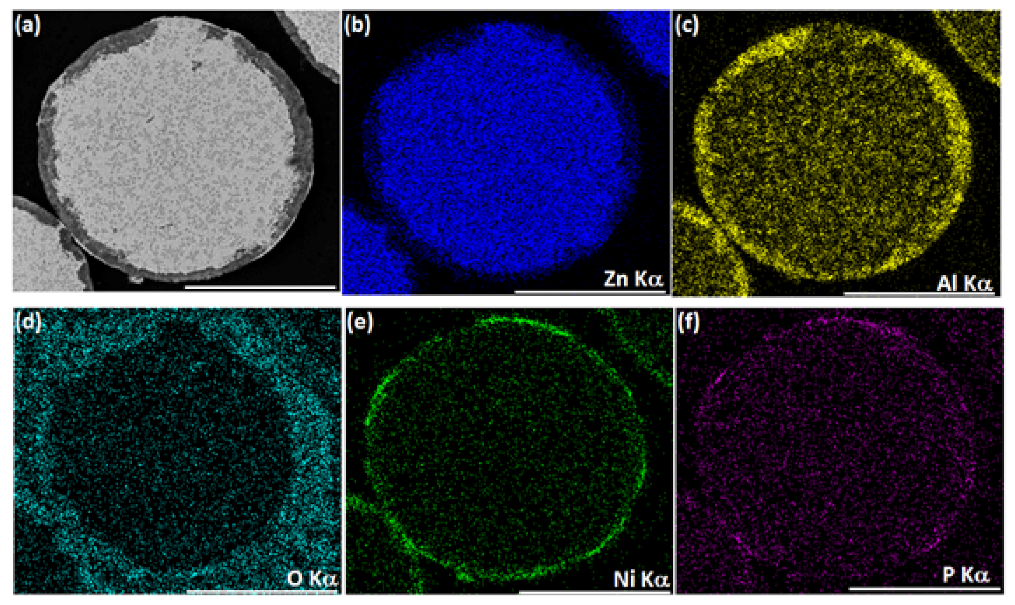

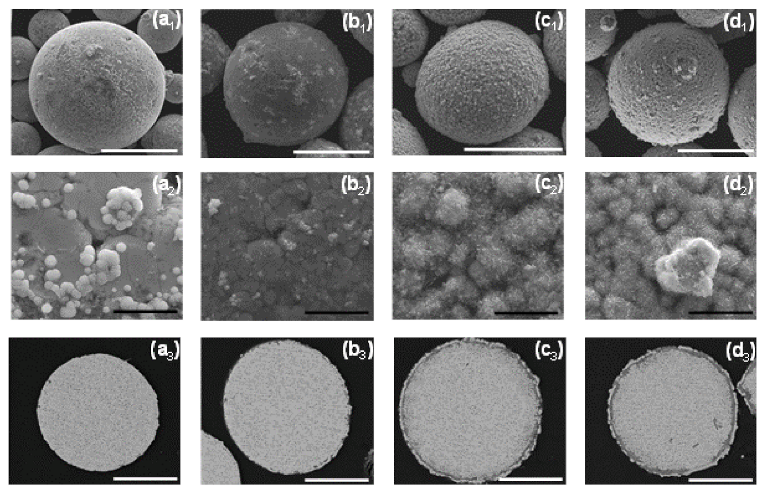

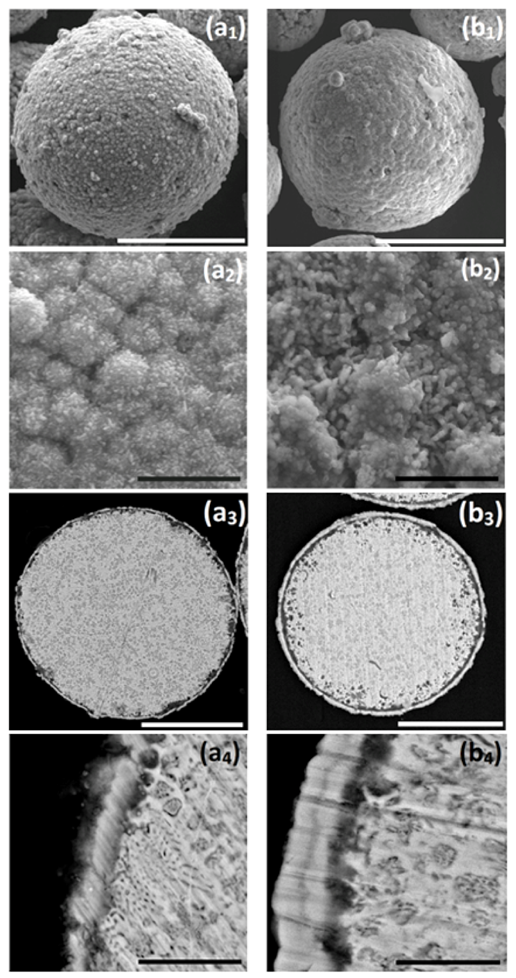

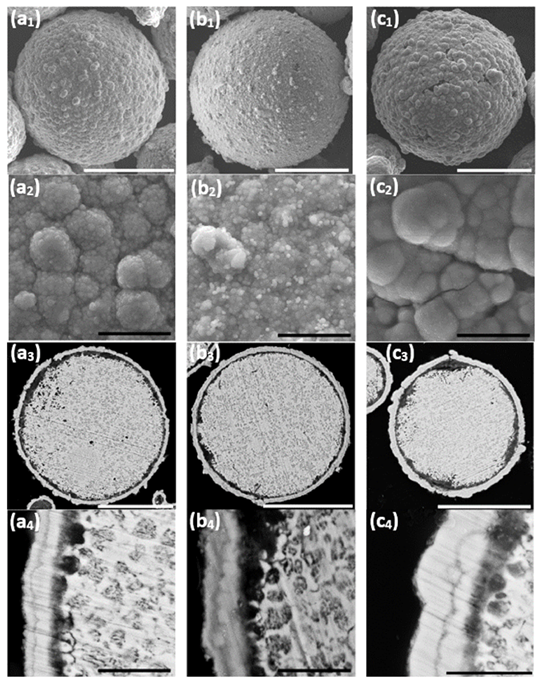
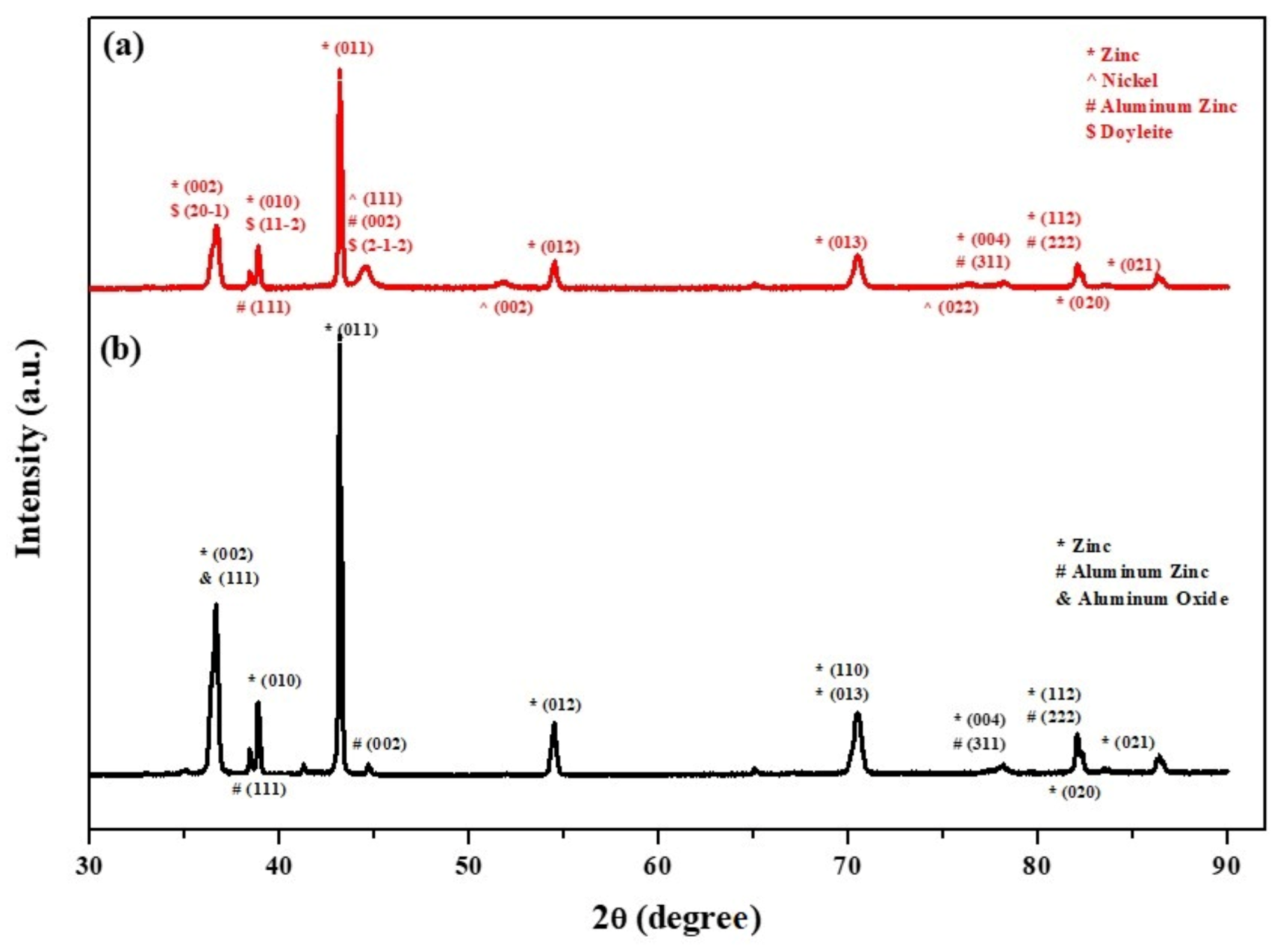
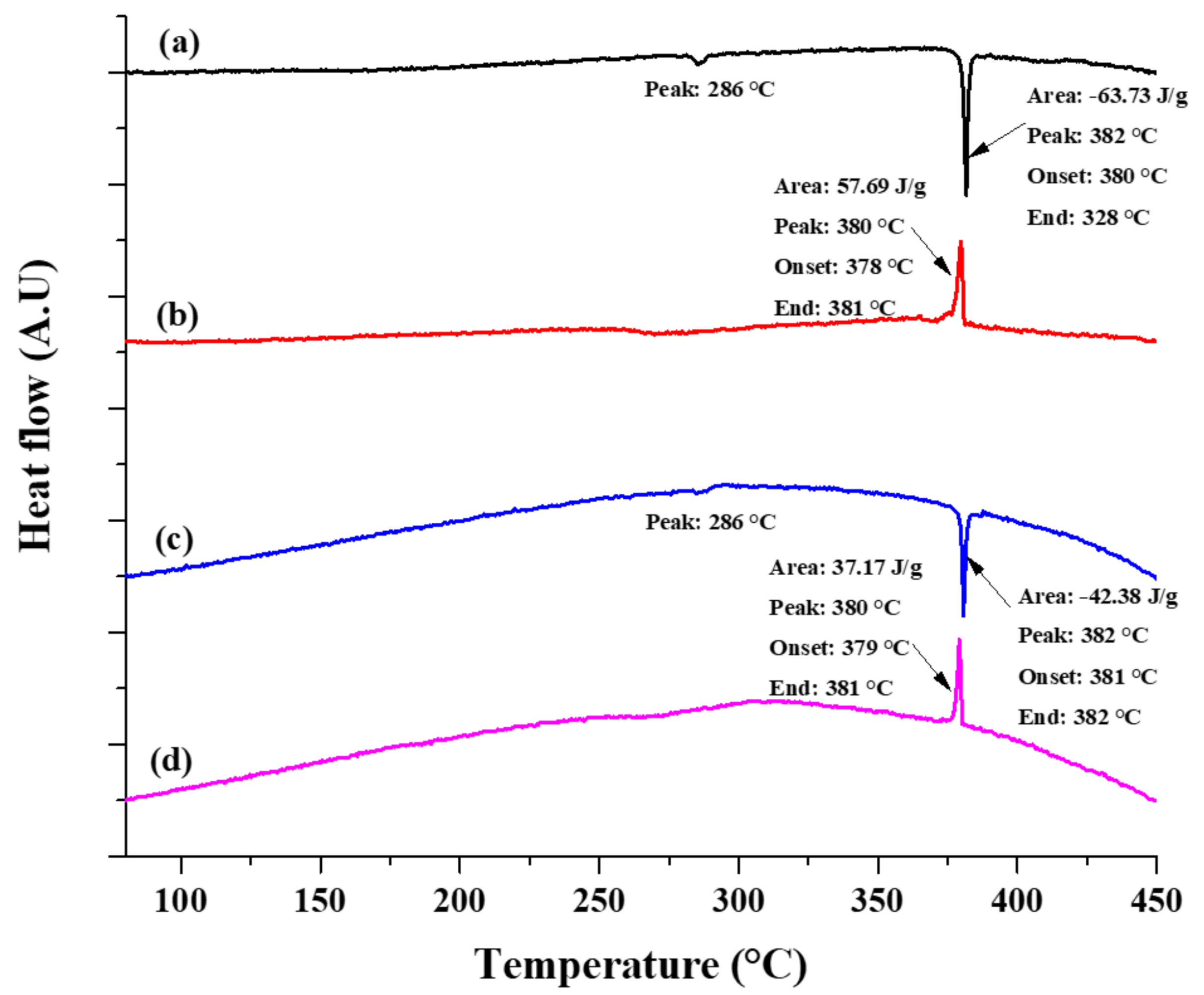

| Element | Concentration, wt.% |
|---|---|
| Zn | 91.024 |
| Al | 7.791 |
| Cu | 1.121 |
| Mg | 0.021 |
| Fe | 0.021 |
| Sn | 0.020 |
| Pb | 0.002 |
| Bath Composition and Deposition Conditions | Solution 1 | Solution 2 |
|---|---|---|
| NiSO4·6H2O (M) | - | 0.12 |
| Na3C6H5O7·2H2O (M) | - | 0.14 |
| NaH2PO2·H2O (M) | - | 0.40 |
| Solvent | Ethanol absolute | Deionized (DI) water |
| pH | - | 9 |
| Temperature (°C) | 55–60, 65–70,70–75 | 45–50 |
| NiCl2·6H2O (M) | 0.05, 0.1, 0.2, 0.3 | - |
| Time (min) | 15, 30, 60 | 25, 35, 75 |
| Sample | ΔHm J/g | ΔHc J/g | Encapsulation Ratio, % | Encapsulation Efficiency, % | Thermal Storage Capability, % |
|---|---|---|---|---|---|
| Core | 63.73 | 57.69 | N/A | N/A | N/A |
| Core-shell | 42.38 | 37.17 | 66.50 | 65.52 | 98.52 |
Publisher’s Note: MDPI stays neutral with regard to jurisdictional claims in published maps and institutional affiliations. |
© 2021 by the authors. Licensee MDPI, Basel, Switzerland. This article is an open access article distributed under the terms and conditions of the Creative Commons Attribution (CC BY) license (http://creativecommons.org/licenses/by/4.0/).
Share and Cite
Svetlizky, D.; Kazimierczak, H.; Ovadia, B.; Sharoni, A.; Eliaz, N. Electrochemical Processing and Thermal Properties of Functional Core/Multi-Shell ZnAl/Ni/NiP Microparticles. Materials 2021, 14, 834. https://doi.org/10.3390/ma14040834
Svetlizky D, Kazimierczak H, Ovadia B, Sharoni A, Eliaz N. Electrochemical Processing and Thermal Properties of Functional Core/Multi-Shell ZnAl/Ni/NiP Microparticles. Materials. 2021; 14(4):834. https://doi.org/10.3390/ma14040834
Chicago/Turabian StyleSvetlizky, David, Honorata Kazimierczak, Bar Ovadia, Ariel Sharoni, and Noam Eliaz. 2021. "Electrochemical Processing and Thermal Properties of Functional Core/Multi-Shell ZnAl/Ni/NiP Microparticles" Materials 14, no. 4: 834. https://doi.org/10.3390/ma14040834
APA StyleSvetlizky, D., Kazimierczak, H., Ovadia, B., Sharoni, A., & Eliaz, N. (2021). Electrochemical Processing and Thermal Properties of Functional Core/Multi-Shell ZnAl/Ni/NiP Microparticles. Materials, 14(4), 834. https://doi.org/10.3390/ma14040834







